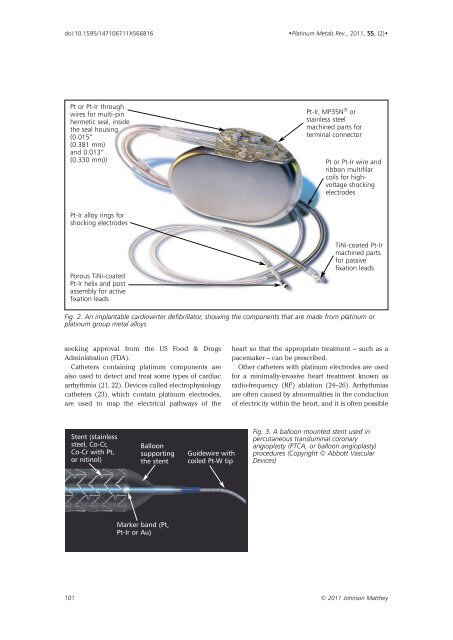Download - Platinum Metals Review
Download - Platinum Metals Review
Download - Platinum Metals Review
You also want an ePaper? Increase the reach of your titles
YUMPU automatically turns print PDFs into web optimized ePapers that Google loves.
doi:10.1595/147106711X566816<br />
•<strong>Platinum</strong> <strong>Metals</strong> Rev., 2011, 55, (2)•<br />
Pt or Pt-Ir through<br />
wires for multi-pin<br />
hermetic seal, inside<br />
the seal housing<br />
(0.015”<br />
(0.381 mm)<br />
and 0.013”<br />
Pt-Ir, MP35N ® or<br />
stainless steel<br />
machined parts for<br />
terminal connector<br />
(0.330 mm)) Pt or Pt-Ir wire and<br />
ribbon multifilar<br />
coils for highvoltage<br />
shocking<br />
electrodes<br />
Pt-Ir alloy rings for<br />
shocking electrodes<br />
Porous TiNi-coated<br />
Pt-Ir helix and post<br />
assembly for active<br />
fixation leads<br />
TiNi-coated Pt-Ir<br />
machined parts<br />
for passive<br />
fixation leads<br />
Fig. 2. An implantable cardioverter defibrillator, showing the components that are made from platinum or<br />
platinum group metal alloys<br />
seeking approval from the US Food & Drugs<br />
Administration (FDA).<br />
Catheters containing platinum components are<br />
also used to detect and treat some types of cardiac<br />
arrhythmia (21, 22). Devices called electrophysiology<br />
catheters (23), which contain platinum electrodes,<br />
are used to map the electrical pathways of the<br />
heart so that the appropriate treatment – such as a<br />
pacemaker – can be prescribed.<br />
Other catheters with platinum electrodes are used<br />
for a minimally-invasive heart treatment known as<br />
radio-frequency (RF) ablation (24–26). Arrhythmias<br />
are often caused by abnormalities in the conduction<br />
of electricity within the heart, and it is often possible<br />
Stent (stainless<br />
steel, Co-Cr,<br />
Co-Cr with Pt,<br />
or nitinol)<br />
Balloon<br />
supporting<br />
the stent<br />
Guidewire with<br />
coiled Pt-W tip<br />
Fig. 3. A balloon-mounted stent used in<br />
percutaneous transluminal coronary<br />
angioplasty (PTCA, or balloon angioplasty)<br />
procedures (Copyright © Abbott Vascular<br />
Devices)<br />
Marker band (Pt,<br />
Pt-Ir or Au)<br />
101 © 2011 Johnson Matthey
















